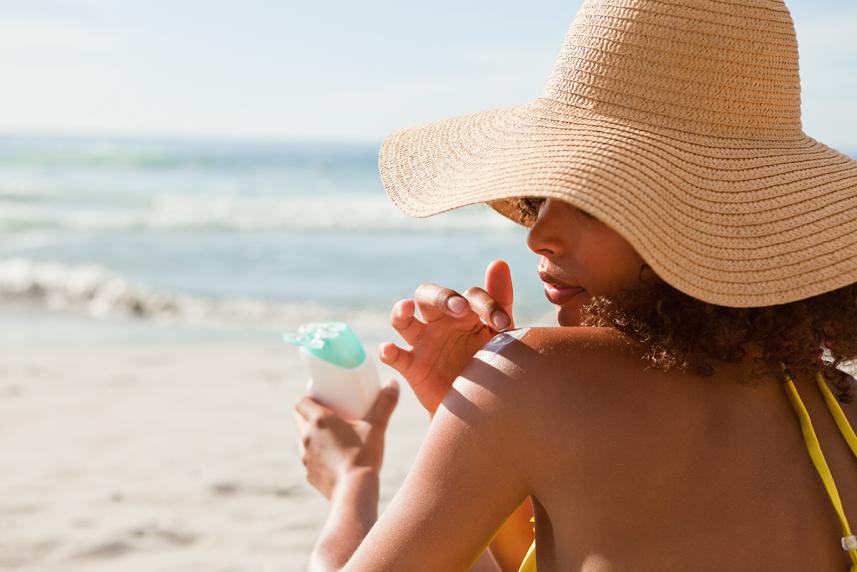
Refill medications, schedule a virtual visit, or shop for health essentials all from the comfort of home.

Which SPF is best? Should you use a lotion or spray? We’ve got the facts to help you and your family stay safe in the sun.
You’ve booked a beach getaway, and you’re looking forward to some serious rest, relaxation and sunshine. So pack your swimsuit, shorts and flip-flops — and bring plenty of sunscreen.
Sunscreen is an essential that you can’t forget when you travel. That’s because it helps block the sun’s harmful rays and can help reduce your risk of skin cancer. (Not to mention, it helps prevent wrinkles and age spots.)
But when you stand in front of a huge display of sunscreens at the drugstore, it’s easy to get overwhelmed. Here’s how to choose and use sunscreen.
First, it helps to understand some basic science about the sun. Sunlight is a source of ultraviolet (UV) rays, a particular wavelength of light. There are two main types of UV rays that damage the skin:
An easy way to remember the difference? “B for burning and A for aging,” says Rajani Katta, MD. She’s a board-certified dermatologist in private practice in Houston. You might know from experience that a painful sunburn can ruin a vacation. It makes your skin hot, red and tender.
And don’t kid yourself: A suntan is also a form of skin damage. There’s no such thing as a safe, healthy tan.
Stock up on your spring vacation sunscreen needs at the Optum Store. Shop now.
When you read a sunscreen label, pay attention to these key terms:
SPF. SPF stands for sun protection factor. The number after it tells how much UVB light the product can filter out. Dermatologists recommend using a sunscreen with at least an SPF 30. In fact, you should slather on an SPF of 30 or higher sunscreen every day, whether you’re on vacation or hanging out in your backyard.
You can buy sunscreens with SPFs of up to 110. But you get only a small amount of extra protection from those higher numbers. According to the American Cancer Society (ACS), SPF 30 sunscreens filter out about 97% of UVB rays, SPF 50 sunscreens about 98%, and SPF 100 about 99%.
Broad spectrum. Since SPF applies only to UVB rays, you should also check that your sunscreen protects against UVA rays. Look on the front of the bottle for the term “broad spectrum,” says Dr. Katta.
Water resistant. No sunscreen is waterproof. But those labeled “water resistant” will stay on your skin for 40 minutes in the water, per the American Academy of Dermatology (AAD). This is nice to have if you’ve got kids who spend lots of time in the pool. Remember to reapply each time they get out.
Short answer: More than you think. Experts recommend using 2 tablespoons of sunscreen (the amount that would fill a shot glass) for your face and body each time you apply. If you’re just applying cream or lotion to your face, aim for a nickel-sized dollop.
It’s best to apply your sunscreen 15 to 30 minutes before you go outside. If you’re changing into your swimsuit, put on your sunscreen first. This reduces the chance that you’ll miss those areas along the edge of your bathing suit line that tend to burn.
Then reapply sunscreen every 2 hours to get the full benefit of the SPF, says Stephanie Cotell, MD. She is a board-certified dermatologist at Northeast Dermatology in Gahanna, Ohio.
(Did you still end up with a sunburn and need some healing help? Schedule a virtual visit with one of our doctors here.)
These days you can get sun protection in a variety of formulations: creams, lotions, gels, balms, sticks, sprays and even powders. Which do you pick?
“The best sunscreen is the one that the patient will actually use,” says Dr. Cotell. “Formulations are really a matter of personal preference.” That means you should choose a sunscreen that you find pleasant to use and easy to reapply.
A stick sunscreen will be harder to rub off or less likely to get into your eyes. Some people like to use sticks for easy-to-miss spots such as the tops of the ears, under the eyes and along the part.
If you prefer sprays for your kids, get in the habit of rubbing it into their skin after spraying it on, as it’s easy to miss areas because the spray is clear. “I usually recommend covering a child with a cream or lotion first, since these provide more consistent coverage,” says Dr. Cotell. Then you can use a spray for touching it up later in the day.
Sunscreens come in chemical and mineral forms. Both protect you from the sun but in different ways, according to the AAD. Chemical sunscreens work by absorbing the sun’s rays. Mineral sunscreens sit on the surface of the skin and deflect UV rays. (Check out the wide range of sunscreen formulations at the Optum Store.)
Yes. Various claims that certain chemical sunscreen ingredients are unsafe or toxic have not been proved, according to the AAD. The Food and Drug Administration, AAD and ACS all say that the risks of not using sunscreen far outweigh any risks of using it. If you’re concerned, choose a mineral sunscreen or discuss your options with your dermatologist.
(You may have read that in 2021 several brands of aerosol sunscreens were recalled because they were found to be contaminated with benzene, a carcinogen. However, it’s important to know that benzene is not a sunscreen ingredient.)
What about the term “reef safe” that you see on some sunscreen labels? Some studies have raised concerns that oxybenzone and octinoxate (two common sunscreen ingredients) may damage coral reefs. That’s according to the Skin Cancer Education and Research Foundation. A product labeled “reef safe” doesn’t contain those ingredients.
Absolutely. It’s a myth that people with darker-toned skin can skip sunscreen. UVB rays are a major contributor to skin cancer, no matter your skin color. The aging effects of UVA rays also still apply. People of color are also at greater risk of hyperpigmentation, thanks to sun exposure, says Dr. Cotell.
Are there other precautions I should take?
Whichever form of sunscreen you choose, you can’t rely on it for complete protection in the sun, experts say. You should also:

Refill medications, schedule a virtual visit, or shop for health essentials all from the comfort of home.
Additional sources
Sunscreen facts: American Academy of Dermatology (n.d.). “How to Decode Sunscreen Labels”
SPF statistics: American Cancer Society (2019). “How Do I Protect Myself from Ultraviolet (UV) Rays?”
Chemical and mineral sunscreens: American Academy of Dermatology (n.d.). “Sunscreen FAQs”
Sunscreen safety: American Academy of Dermatology (n.d.). “Sunscreen FAQs”
Food and Drug Administration (2020): “Shedding More Light on Sunscreen Absorption”
American Cancer Society (2020): “Spend More Time Outside and Stay Sun-Safe”
Reef safe: Skin Cancer Education and Research Foundation (n.d.): “Prevention of Skin Cancer: Sun Safety”
Sun and eye health: American Academy of Ophthalmology (2021). “Tips for Choosing the Best Sunglasses”